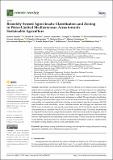Por favor, use este identificador para citar o enlazar a este item:
http://hdl.handle.net/10261/341583COMPARTIR / EXPORTAR:
 SHARE SHARE
 CORE
BASE CORE
BASE
|
|
| Visualizar otros formatos: MARC | Dublin Core | RDF | ORE | MODS | METS | DIDL | DATACITE | |

| Título: | Remotely Sensed Agroclimatic Classification and Zoning in Water-Limited Mediterranean Areas towards Sustainable Agriculture |
Autor: | Faraslis, Ioannis; Dalezios, Nicolas R.; Alpanakis, Nicolás; Tziatzios, Georgios A.; Spiliotopoulos, Marios; Sakellariou, Stavros; Sidiropoulos, Pantelis; Dercas, Nicholas; Domínguez, Alfonso; Martínez-López, José Antonio; López-Urrea, Ramón; Karam, Fadi; Amami, Hacib; Nciri, Radhouan | Palabras clave: | Agroclimatic zoning Hydroclimatic zoning Non-crop-specific zoning Crop-specific zoning Agricultural suitability zones Mediterranean agroecosystems |
Fecha de publicación: | 13-dic-2023 | Editor: | Multidisciplinary Digital Publishing Institute | Citación: | Remote Sensing 15(24): 5720 (2023) | Resumen: | Agroclimatic classification identifies zones for efficient use of natural resources leading to optimal and non-optimal crop production. The aim of this paper is the development of a methodology to determine sustainable agricultural zones in three Mediterranean study areas, namely, “La Mancha Oriental” in Spain, “Sidi Bouzid” in Tunisia, and “Bekaa” valley in Lebanon. To achieve this, time series analysis with advanced geoinformatic techniques is applied. The agroclimatic classification methodology is based on three-stages: first, the microclimate features of the region are considered using aridity and vegetation health indices leading to water-limited growth environment (WLGE) zones based on water availability; second, landform features and soil types are associated with WLGE zones to identify non-crop-specific agroclimatic zones (NCSAZ); finally, specific restricted crop parameters are combined with NCSAZ to create the suitability zones. The results are promising as compared with the current crop production systems of the three areas under investigation. Due to climate change, the results indicate that these arid or semi-arid regions are also faced with insufficient amounts of precipitation for supporting rainfed annual crops. Finally, the proposed methodology reveals that the employment and use of remote sensing data and methods could be a significant tool for quickly creating detailed, and up to date agroclimatic zones. | Versión del editor: | https://doi.org/10.3390/rs15245720 | URI: | http://hdl.handle.net/10261/341583 | DOI: | 10.3390/rs15245720 | E-ISSN: | 2072-4292 | Identificadores: | doi: 10.3390/rs15245720 |
| Aparece en las colecciones: | (CIDE) Artículos |
Ficheros en este ítem:
| Fichero | Descripción | Tamaño | Formato | |
|---|---|---|---|---|
| remotesensing-15-05720-v3.pdf | 11,89 MB | Adobe PDF |  Visualizar/Abrir |
CORE Recommender
SCOPUSTM
Citations
2
checked on 20-may-2024
Page view(s)
14
checked on 24-may-2024
Download(s)
18
checked on 24-may-2024
Google ScholarTM
Check
Altmetric
Altmetric
Este item está licenciado bajo una Licencia Creative Commons

